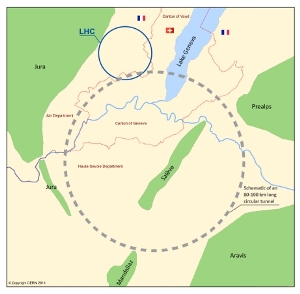Feb 7 2014
Particle physics takes the long-term view. Originally conceived in the 1980s, the LHC took another 25 years to come into being. This accelerator, which is unlike any other, is just at the start of a programme which is expected to run for another 20 years. Even now, as consolidation work aimed at a restart in 2015 continues, detailed plans are being hatched for a large-scale upgrade to increase luminosity and thereby exploit the LHC to its full potential.
The HL (High Luminosity) LHC is CERN’s number-one priority and will increase the number of collisions accumulated in the experiments by a factor of ten from 2024 onwards.
 Schematic of an 80-100 km long circular tunnel
Schematic of an 80-100 km long circular tunnel
Even though the LHC programme is already well defined for the next two decades, the time has come to look even further ahead, so CERN is now initiating an exploratory study for a future long-term project centred on a new-generation circular collider with a circumference of 80 to 100 kilometres. A worthy successor to the LHC, whose collision energies will reach 14 TeV, such an accelerator would allow particle physicists to push back the boundaries of knowledge even further. The Future Circular Colliders (FCC) programme will focus especially on studies for a hadron collider, similar to the LHC, capable of reaching unprecedented energies in the region of 100 TeV.
The FCC study will be a global venture for particle physics and stems from the recommendation in the European Strategy for Particle Physics, published in May 2013, that a feasibility study be conducted on future fundamental research projects at CERN. It will be conducted over the coming five years and starts with an international kick-off meeting at the University of Geneva from 12 to 15 February.
The FCC will thus run in parallel with another study that has already been under way for a number of years, the Compact Linear Collider, or “CLIC”, another option for a future accelerator at CERN. The aim of the CLIC study is to investigate the potential of a linear collider based on a novel accelerating technology.
“We still know very little about the Higgs boson, and our search for dark matter and supersymmetry continues. The forthcoming results from the LHC will be crucial in showing us which research paths to follow in the future and what will be the most suitable type of accelerator to answer the new questions that will soon be asked,” says Sergio Bertolucci, Director for Research and Computing at CERN.
“We need to sow the seeds of tomorrow’s technologies today, so that we are ready to take decisions in a few years’ time,” adds CERN’s Director for Accelerators and Technology, Frédérick Bordry.
The goal of the two studies is to examine the feasibility of the various possible machines, to evaluate their costs and to produce a conceptual design report for the FCC and elaborate on the one already produced for CLIC in time for the next European Strategy update around 2018/2019.